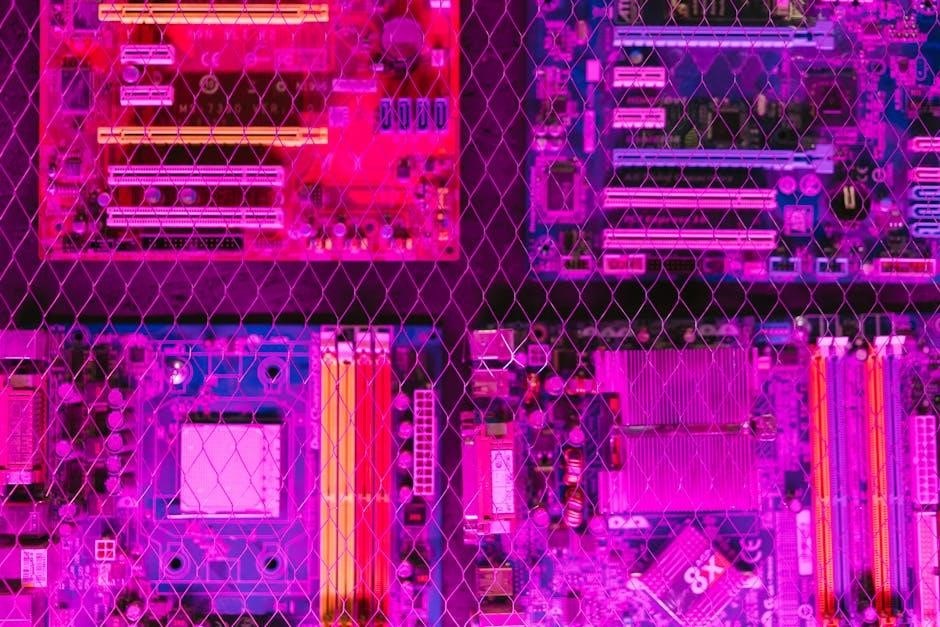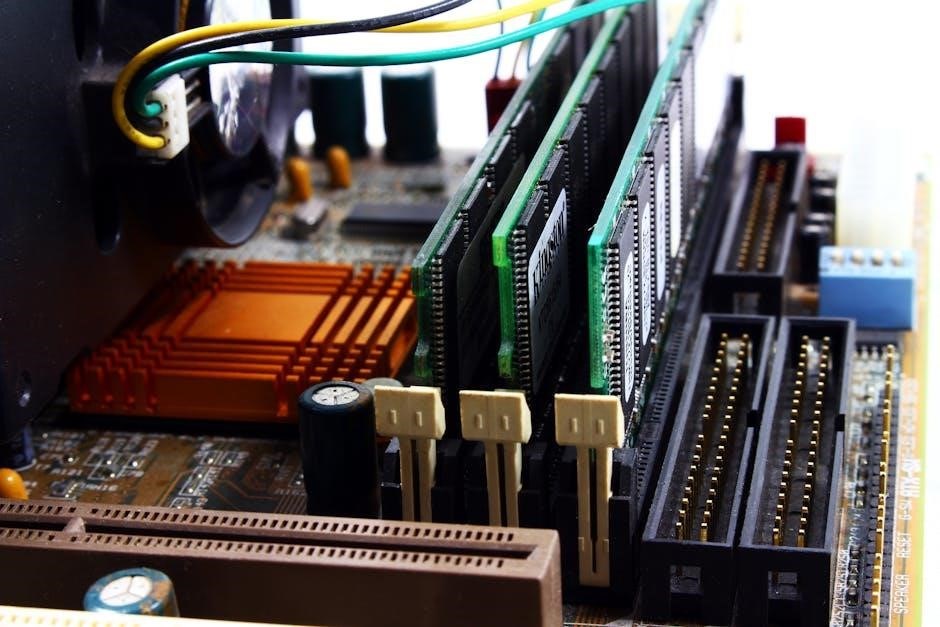Electronic circuits are the fundamental building blocks of modern electronics‚ consisting of interconnected components like power supplies‚ wires‚ and resistors. They enable the flow of electrical energy to power devices‚ process signals‚ and perform essential functions across various applications.
1.1 What Are Electronic Circuits?
Electronic circuits are pathways through which electric current flows‚ consisting of components like resistors‚ capacitors‚ and wires. These circuits control and direct the flow of electrical energy to perform specific tasks‚ enabling functionalities in devices ranging from simple household appliances to complex systems. They are the backbone of modern technology‚ ensuring efficient energy distribution and signal processing across various applications.
1.2 Importance of Electronic Circuits in Modern Technology
Electronic circuits are integral to modern technology‚ powering devices from smartphones to computers. They enable efficient energy distribution‚ signal processing‚ and communication systems. Circuits drive innovation in healthcare‚ automotive‚ and industrial sectors‚ ensuring reliability and performance. Their versatility and adaptability make them indispensable in advancing technologies like AI‚ IoT‚ and renewable energy systems‚ shaping the future of electronics.

Essential Components of a Circuit
A circuit requires a power supply (or battery)‚ wires for connectivity‚ and resistors to control current flow. These components work together to enable electrical energy transfer and functionality.
2.1 Power Supply (or Battery)
A power supply or battery is the heart of any circuit‚ providing the necessary voltage and current to drive components. It converts stored chemical energy into electrical energy‚ enabling devices to function. Proper selection ensures stable operation‚ while incorrect voltage can damage components. Batteries are portable and commonly used‚ while power supplies are often fixed and regulate output precisely.
2.2 Wires and Resistors
Wires are conductors that carry electrical current‚ connecting components in a circuit. Resistors‚ on the other hand‚ limit current flow and voltage across components. They are essential for protecting sensitive devices and controlling signal levels. Proper selection of resistors ensures optimal performance‚ while wires ensure reliable connections‚ maintaining the flow of electrical energy throughout the circuit.

Types of Circuits
Circuits are categorized into types based on configuration. Series circuits connect components end-to-end‚ while parallel circuits connect them across each other‚ affecting current and voltage distribution.
3.1 Series Circuits
A series circuit connects components end-to-end‚ forming a single path for current flow. In such circuits‚ the current remains consistent across all components‚ while voltage can vary. If one component fails‚ the entire circuit is disrupted. Series circuits are often used for simple applications‚ such as powering LEDs or basic alarms‚ where uniform current distribution is essential for proper operation.
3.2 Parallel Circuits
In a parallel circuit‚ components are connected across each other‚ providing multiple paths for current flow. This configuration allows individual components to operate independently‚ maintaining consistent voltage across each branch. If one component fails‚ others continue functioning. Parallel circuits are commonly used in household wiring and electronic devices where voltage consistency and redundancy are crucial for reliable performance and safety.
Circuit Analysis and Design
Circuit analysis and design involve understanding electrical principles‚ using simulation tools‚ and prototyping to create efficient and functional circuits for various applications.
4.1 Theoretical Foundations of Circuit Analysis
Circuit analysis relies on fundamental electrical laws‚ including Ohm’s Law and Kirchhoff’s Laws‚ which govern voltage‚ current‚ and resistance relationships. These principles‚ combined with Thevenin’s and Norton’s Theorems‚ enable engineers to simplify and analyze complex circuits‚ ensuring efficient design and functionality across various applications.
4.2 Practical Applications of Circuit Design
Circuit design is crucial for solving real-world problems‚ enabling advancements in consumer electronics‚ automotive systems‚ and medical devices. It ensures efficient power delivery‚ reliable signal processing‚ and robust control systems. By applying theoretical knowledge‚ engineers create circuits that enhance performance‚ safety‚ and functionality across diverse industries‚ driving innovation and improving everyday technologies.
Tools and Software for Circuit Design
Circuit simulation software and PCB design tools are essential for creating and testing electronic circuits‚ enabling efficient design‚ analysis‚ and optimization of complex circuitry.
5.1 Circuit Simulation Software
Circuit simulation software‚ such as SPICE or Multisim‚ allows engineers to design and test electronic circuits virtually. These tools simulate circuit behavior‚ enabling precise analysis of voltage‚ current‚ and power. They are invaluable for troubleshooting and optimizing designs before physical prototyping‚ reducing costs and time. Such software is widely used in education and industry for both simple and complex circuit modeling‚ ensuring accuracy and reliability.
5.2 PCB Design Tools
PCB design tools‚ such as Eagle‚ KiCad‚ and Altium Designer‚ enable the creation of printed circuit board layouts; These tools offer features like schematic capture‚ layout design‚ and simulation. They help engineers design and optimize PCBs for manufacturability‚ ensuring proper signal integrity and thermal management. Advanced tools also support collaboration‚ making it easier for teams to work on complex projects efficiently. These tools are essential for modern electronics development.

Safety Precautions in Circuit Handling
When handling circuits‚ always disconnect power supplies‚ use multimeters to check for voltage‚ avoid short circuits‚ and be cautious of hot components. Wear protective gear.
6.1 Understanding Circuit Safety
Understanding circuit safety is crucial to prevent accidents and ensure reliable operation. Key principles include disconnecting power before work‚ using multimeters to verify voltage absence‚ and avoiding short circuits. Always inspect components for damage‚ as faulty parts can cause unexpected hazards. Grounding and proper insulation are essential to protect against electric shock. Familiarize yourself with circuit diagrams to anticipate potential risks and take precautions accordingly.
- Avoid touching live components to prevent electric shock.
- Use protective gear like gloves and goggles when handling circuits.
- Ensure proper ventilation to prevent overheating and fire risks.
By following these guidelines‚ you can minimize risks and work safely with electronic circuits.
6.2 Common Hazards and Prevention Tips
Common hazards in circuit handling include short circuits‚ electrical shocks‚ and component overheating. To prevent these‚ ensure proper insulation‚ avoid overloaded circuits‚ and use surge protectors. Regularly inspect wires and connections for damage. Keep circuits away from flammable materials and avoid touching live components. Use protective gear like gloves and goggles. Always disconnect power sources before making adjustments to ensure safety during repairs or modifications.
Applications of Circuits in Consumer Electronics
Electronic circuits power consumer devices like smartphones‚ laptops‚ and televisions‚ enabling functionality and efficiency. They are crucial for signal processing‚ power supply‚ and connectivity in modern electronics‚ enhancing user experience.
7.1 Power Supply Circuits
Power supply circuits are essential for delivering stable voltage and current to electronic devices. They convert alternating current (AC) to direct current (DC)‚ ensuring efficient energy distribution. These circuits often include transformers‚ rectifiers‚ and capacitors to regulate output‚ making them critical for powering consumer electronics like smartphones‚ laptops‚ and televisions. Proper design ensures reliability and safety in various applications‚ preventing voltage fluctuations and overheating issues. Additionally‚ modern power supply circuits incorporate advanced components to achieve high efficiency and minimize environmental impact. Their versatility allows them to be tailored for specific devices‚ ensuring optimal performance and longevity. By maintaining consistent power delivery‚ they play a vital role in the functionality and durability of modern electronics.
7.2 Signal Processing Circuits
Signal processing circuits are designed to modify or synthesize electrical signals‚ enabling tasks like amplification‚ filtering‚ and modulation. These circuits are vital in audio equipment‚ communication systems‚ and medical devices. Using components such as amplifiers‚ filters‚ and microcontrollers‚ they enhance signal quality‚ reduce noise‚ and enable precise data transmission. Their applications range from improving sound clarity in speakers to processing digital signals in smartphones‚ ensuring reliable performance across industries. By optimizing signal integrity‚ they play a crucial role in modern electronics‚ facilitating accurate and efficient data processing. Their versatility and adaptability make them indispensable in both analog and digital systems‚ driving innovation in technology.
The Role of Circuits in Automotive Systems
Automotive systems rely on electronic circuits to control and monitor vehicle functions. Electronic Control Modules (ECMs) manage engines‚ brakes‚ and safety systems‚ ensuring optimal performance and reliability. These circuits process sensor data‚ regulate power distribution‚ and enable advanced features like cruise control and collision avoidance‚ enhancing overall driving safety and efficiency.
8.1 Electronic Control Modules (ECMs)
Electronic Control Modules (ECMs) are central to modern automotive systems‚ managing critical functions like engine control‚ fuel injection‚ and emissions. They process sensor data in real-time‚ ensuring optimal performance and efficiency. ECMs also handle diagnostics‚ detecting faults and storing error codes for troubleshooting. These modules are integral to safety systems‚ such as airbags and anti-lock braking‚ making them indispensable in contemporary vehicles.
8.2 Wiring and Circuit Diagnosis
Wiring and circuit diagnosis in automotive systems involves identifying faults in the electrical network. Common issues include blown fuses‚ faulty sensors‚ and wiring damage. Technicians use tools like scan tools to detect error codes and trace malfunctions. Proper diagnosis ensures the ECM functions correctly‚ maintaining system reliability and efficiency. Regular checks prevent cascading failures‚ ensuring optimal vehicle performance and safety.

Circuit Diagrams and Schematics
Circuit diagrams and schematics provide visual representations of electronic circuits‚ detailing components and their connections. They are essential for understanding‚ designing‚ and servicing electronic systems efficiently.
9.1 How to Read a Circuit Diagram
Reading a circuit diagram involves identifying symbols for components like resistors‚ capacitors‚ and transistors. Lines represent wires‚ and labels indicate connections. Start by locating the power source‚ then trace connections to understand the flow of current. Reference guides can help decode unfamiliar symbols‚ ensuring accurate interpretation and troubleshooting of the circuit.
9.2 Creating a Circuit Schematic
Creating a circuit schematic involves mapping components and their connections using standardized symbols. Start by identifying all components‚ such as resistors‚ capacitors‚ and ICs. Use software tools to arrange them logically‚ ensuring clear labeling and connections. Cross-reference with datasheets for accuracy. Organize the layout to avoid clutter‚ making it easy for others to interpret and implement the design effectively.
Educational Resources for Circuit Learning
Explore online courses‚ tutorials‚ and PDF guides for comprehensive circuit learning. eBooks and simulation tools enhance understanding and practical application of circuit design and analysis.
10.1 Online Courses and Tutorials
Discover a wealth of online courses and tutorials on platforms like Udemy‚ Coursera‚ and edX. These resources offer in-depth lessons on circuit theory‚ design‚ and analysis. Many courses include hands-on projects‚ simulations‚ and quizzes to enhance learning. Platforms like Khan Academy and YouTube also provide free tutorials for beginners. These tools are ideal for self-paced learning and skill development in electronics.
10.2 PDF Guides and eBooks
PDF guides and eBooks are invaluable resources for learning about electronic circuits. Websites like faculty.ksu.edu.sa offer comprehensive PDFs on circuit analysis and design. These documents provide detailed explanations‚ diagrams‚ and practical examples. eBooks from platforms like Amazon and Google Books cover a wide range of topics‚ from basic electronics to advanced circuit design. They are perfect for self-study and reference‚ offering in-depth knowledge at your convenience.
Troubleshooting Common Circuit Issues
Troubleshooting circuit issues involves identifying faults like blown fuses‚ faulty components‚ or short circuits. Verify wiring connections and use tools like multimeters for accurate diagnosis and repairs.
11.1 Identifying Faults in a Circuit
Identifying faults in a circuit begins with visual inspections for damaged components or loose connections. Use multimeters to measure voltage‚ current‚ and resistance‚ comparing readings to expected values. Check for short circuits‚ open circuits‚ and faulty components like capacitors or ICs. Logical troubleshooting ensures systematic identification of issues‚ minimizing downtime and facilitating effective repairs.
11.2 Repairing and Optimizing Circuits
Repairing circuits involves replacing faulty components‚ tightening connections‚ and ensuring proper soldering. Optimization focuses on enhancing performance by reducing noise‚ improving efficiency‚ and upscaling design. Use diagnostic tools like multimeters and oscilloscopes to verify repairs. Regular maintenance and upgrading components can prevent future issues‚ ensuring reliable operation and extended circuit lifespan.
Future Trends in Circuit Technology
Future trends in circuit technology include AI-driven designs‚ advanced miniaturization‚ and eco-friendly components‚ enhancing efficiency and sustainability in electronic systems globally.
12.1 Advancements in Circuit Miniaturization
Advancements in circuit miniaturization are revolutionizing electronics‚ enabling smaller‚ more efficient devices. Innovations in materials like graphene and advanced 3D printing techniques allow for nano-scale components. This leads to faster‚ lighter‚ and more powerful circuits‚ reducing energy consumption and enhancing performance. Such progress is critical for next-gen technologies‚ including wearables‚ IoT devices‚ and high-performance computing systems.
12.2 The Role of AI in Circuit Design
AI is transforming circuit design by automating complex tasks‚ enhancing accuracy‚ and reducing development time. Machine learning algorithms optimize component placement and predict circuit performance. Tools like GPT-4 and Claude 3 Opus aid in simulating designs‚ identifying faults‚ and improving efficiency. AI-driven solutions enable rapid prototyping and scalable designs‚ addressing challenges in modern electronics and fostering innovation in circuit technology.




